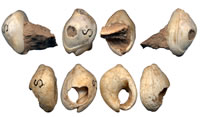Oldest known jewellery discovered
 Beads made from shells represent earliest personal adornment.
Beads made from shells represent earliest personal adornment.It can take hundreds of beads to make a single bracelet, and thousands for a haute couture gown. But it has taken only three shell beads to shake up our theories about human evolution.
The jewellery might not be much by today's standards of bling: they are simple seashells punctured to make rudimentary beads. But archaeologists have dated two of them, from the site of Skhul in Israel, as at least 100,000 years old. This makes them the oldest known items of personal adornment, beating the previous record-holder, a set of similar shell beads found in South Africa's Blombos Cave, by almost 25,000 years.
The third bead, found at Oued Djebbana in Algeria, is younger at just over 35,000 years old, but what it lacks in age it makes up for in location. Found more than 160 kilometres from the sea, its presence clearly suggests intentional human transportation.
The two sites were excavated in the 1930s, but their significance has only recently come to light. "This study refutes the hypothesis that humans only became culturally modern when they entered Europe 40,000 years ago and replaced Neanderthals," says Marian Vanhaeren of University College London, UK, who led the research, published today in Science. Complex behaviour
The discovery is significant because it shows that our ancestors adopted symbolic behaviour much earlier than previously thought, says Vanhaeren. For decades, archaeologists had assumed that the complex behaviours such as language, burials and art first turned up about 40,000 years ago in Europe. So whereas modern humans may have physically evolved in Africa, their cultural development was thought to have largely occurred in Europe.
The Blombos Cave beads, found in 2004, were the first to shake that belief. And the new discoveries extend the geographic and temporal region in which early symbolic activity took place. Vanhaeren's team argues that a "long-lasting and widespread bead-working tradition" existed throughout Africa and the Middle East long before anatomically modern humans arrived in Europe.
This hypothesis does not contradict the appearance of European material 40,000 years ago, but instead challenges ideas about its role in human evolution, says Vanhaeren's colleague Chris Stringer, an anthropologist at the Natural History Museum in London. "What we find in Europe is very spectacular. The painted caves are very special, and we've found nothing like them yet in Africa or Asia," he says. "But we now know that the basic framework for that behaviour was already present around 100,000 years ago."
It is difficult to imagine any use for the pierced shells rather than as personal decoration, says Vanhaeren. But the use of jewellery suggests a complex social system. Beads and pendants may be used in gift-giving, as markers of ethnic, social or personal identity, or even as amulets. "When you put a personal ornament on your body, you are sending a message to other people," she says. "It is a silent language, but very powerful."
It is possible that other forms of symbolic material, such as wooden beads or bark paintings, may have existed before 100,000 years ago and simply not survived, Stringer suggests. "The Blombos find showed us how we can use beads as a window to social complexity. But it is only one window and there are many more to open."
Oldest known jewellery discovered

0 Comments:
Post a Comment
<< Home